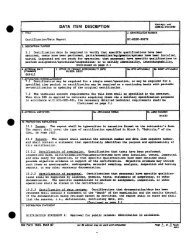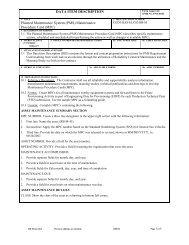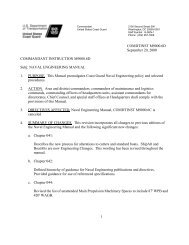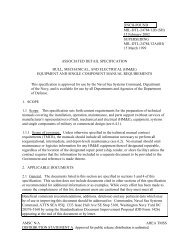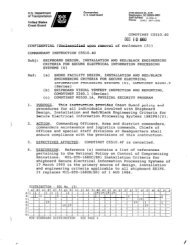comdtinst m2400.1f - US Coast Guard Response Boat-Medium
comdtinst m2400.1f - US Coast Guard Response Boat-Medium
comdtinst m2400.1f - US Coast Guard Response Boat-Medium
You also want an ePaper? Increase the reach of your titles
YUMPU automatically turns print PDFs into web optimized ePapers that Google loves.
1.E.5. Abbreviations. Abbreviations used in this publication.<br />
CW - Continuous Wave<br />
FM - Frequency Modulation<br />
MCW - Modulated Continuous Wave<br />
P - Primary Frequency(ies)<br />
RATT - Radio Teletype<br />
S - Secondary Frequency(ies)<br />
SSB - Single Sideband<br />
V - Voice<br />
NIB - Not-to-Interfere Basis<br />
ISB - Independent Sideband<br />
NBDP - Narrow-band direct printing, also called SITOR or radiotelex<br />
F. Local Arrangements. Nothing in this manual is intended to<br />
abrogate any local arrangements made by district commanders for<br />
establishing liaison circuits with other agencies needed to<br />
accomplish assigned missions. However, the details of such<br />
arrangements must be forwarded to the Commandant (G-TTM) for approval<br />
by the appropriate radio frequency assignment authority and inclusion<br />
in this manual.<br />
G. Vacant.<br />
H. Compatibility of Equipment.<br />
Tuning Capability. Certain single sideband radio equipments within<br />
the <strong>Coast</strong> <strong>Guard</strong> are limited to integral, 1 kilohertz tuning<br />
increments in the operating band (example: 2670, 2671, 2672 kHz as<br />
shown on the equipment tuning dial). These equipments cannot tune to<br />
other frequencies within the 1 kHz integrals (e.g., 2670.4 kHz).<br />
Accordingly, those <strong>Coast</strong> <strong>Guard</strong> SSB equipments that do not possess 100<br />
hertz incremental tuning capability, shall follow the interim<br />
procedures listed below when the carrier frequency does not fall on a<br />
whole kHz step (noting that the carrier frequency for H3E/J3E and F1B<br />
emissions are normally located 1.4 kHz and 2.0 kHz respectively below<br />
the assigned frequency unless otherwise indicated:<br />
1. Emission. Subtract 1.4 kHz (2K8H3E/J3E emission) or 2.0 kHz<br />
(280HF1B/1K24F1B emission) from the assigned frequency.<br />
2. Remainder. Round out the remainder to the nearest whole kHz<br />
step (0.1 through 0.5 to the lower step, 0.6 through 0.9 to<br />
the higher step).<br />
3. Carrier or Dial Frequency. Place the carrier or dial<br />
frequency on the resulting whole kHz step and use upper<br />
sideband emission.<br />
4. NBDP Offset. Frequency offset for NBDP (SITOR) using<br />
exclusive maritime narrowband channels (500 Hz) should be<br />
1700 Hz to preclude the residual carrier energy falling within<br />
the pass band of the lower adjacent channel.<br />
1-3





